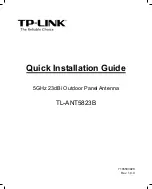
Configuration
QB.11-R Installation and Management
Interface Parameters
73
•
Maximum Satellites:
Only one SU can connect to the BSU. This is a read-only field.
•
No-Sleep Mode:
This field is applicable in point-to-multipoint mode only; it has no effect on QuickBridge.11 units.
•
Automatic Multi-Frame Bursting:
In order to achieve higher throughput, WORP protocol allows each side (BSU or
SU) to send a burst of up to 4 data messages instead of a single data message. The sole criteria for sending a burst is
enough traffic to be sent out. This feature is called Multi-Frame Bursting support.
Automatic Multi-Frame bursting optimizes multi-burst performance when configuring QoS high-priority Service Flows.
Three scenarios may be defined:
–
No Multi-Frame Burst Support
–To disable Multi-Frame burst support, click
Configure
>
Network
>
Roaming,
and select “Disable” on the drop-down box. In this case, each active SFC is limited to send a single data message.
Total throughput available to remaining best effort traffic is around 76% of the maximum available throughput.
–
Multi-Frame Burst Support
– The system will enable Multi-Frame burst for
all
SFCs, but the maximum number of
data messages sent in a burst will be defined by the parameter “Number of data messages in a burst” for each of
the SFCs (see
. This scenario is set by clicking
Configure
>
Network
>
Roaming
and
enabling Multi-Frame burst on the drop-down box, and disabling
Automatic Multi-Frame Bursting
(this
parameter).
The maximum number of data messages in a burst directly influences the total throughput of the system. Typical
values are:
–
Automatic Multi-Frame Burst Support
– The system will continuously monitor which of the active SFCs has the
highest priority and dynamically enable Multi-Frame burst for the highest priority SFC only, keeping all the lower
priority SFCs with Multi-Frame burst disabled. If there are multiple SFCs having the same, highest priority, all of
them will have Multi-Frame burst enabled. The maximum number of data messages sent in a burst is defined by
the parameter “Number of data messages in a burst” and it can be different for each SFC (see
). This scenario is set by clicking
Configure
>
Network
>
Roaming
and enabling Multi-Frame burst on the
drop-down box (see
), and enabling
Automatic Multi-Frame Bursting
(this parameter). In this case,
even the lowest priority SFC will have Multi-Frame burst dynamically enabled as long as it is the only SFC in the
system that has traffic. By default, configuring even a single high priority SFC with automatic multi-frame bursting
enabled will decrease throughput of low priority best-effort traffic to approximately 76% of maximum available
throughput, because low priority traffic will have Multi-Frame burst disabled to optimize bandwidth for the high
priority traffic.
•
Registration Timeout:
This is the registration process time-out of an SU on a BSU. Default is 5 seconds.
•
Rx Inactivity Timeout:
This is the activity time-out of an SU on a BSU. If no traffic is received on the WORP interface
in the configured time, the unit will reboot. The range is 5 minutes to 600 minutes.
•
Network Secret:
A network secret is a secret password given to all nodes of a network. An SU can only register to a
BSU if it has the same Network Secret. The Network Secret is sent encrypted and can be used as a security option.
•
Input / Output Bandwidth Limit:
These parameters limit the data traffic received on the wireless interface and
transmitted to the wireless interface, respectively. Selections are in steps of 64 Kbps from 64 Kbps to 108,064 Kbps.
Satellite Density
Receive Sensitivity Threshold
Defer Threshold
Large
-95 dBm
-62 dBm
Medium
-86 dBm
-62 dBm
Small
-78 dBm
-52 dBm
Mini
-70 dBm
-42 dBm
Micro
-62 dBm
-36 dBm
No. of messages in a burst:
% of the maximum throughput:
4
100%
3
97.6%
2
92.9%
1
76.2%
















































